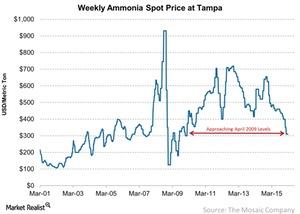Ammonia Prices Fell Slightly from the Previous Week
Ammonia was trading at $310 per metric ton as of the week ending March 4, 2016. It fell $1 from the previous week ending February 26, 2016.
March 7 2016, Published 1:25 p.m. ET

Ammonia
In 2013, only 10% of the global ammonia production was traded according to Yara International. This is because ammonia is the primary nitrogen product used to upgrade to other fertilizer products like urea, UAN (urea ammonium nitrate), and DAP/MAP (diammonium phosphate/monoammonium phosphate).
Ammonia prices
Ammonia was trading at $310 per metric ton as of the week ending March 4, 2016. It fell $1 from the previous week ending February 26, 2016. Ammonia prices fell almost 34% from $475 per metric ton during the same week a year ago. The prices have fallen to the lowest levels since April 2009.
Ammonia prices fell primarily due to lower natural gas costs. There are positives and negatives for falling ammonia prices. Since most of the ammonia is upgraded to other fertilizers, lower prices benefit companies that don’t sell it directly to the market. However, the low price also makes higher cost producers more competitive.
Investors in nitrogen fertilizer companies such as CF Industries (CF), Terra Nitrogen (TNH), CVR Partners (UAN), and PotashCorp (POT) must track ammonia prices closely. Investors can also look into the VanEck Vectors Agribusiness (MOO). MOO invests about 30% of its portfolio in the agricultural chemicals industry.
Since most of the global ammonia production is converted into urea, we’ll look at urea price trends in more detail in the next part.
